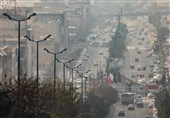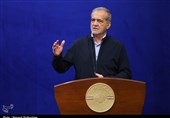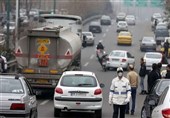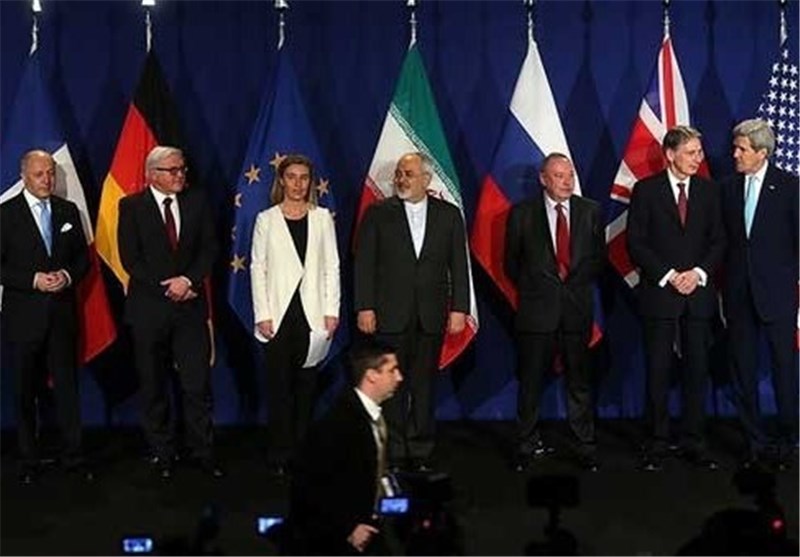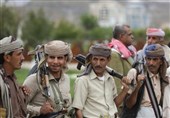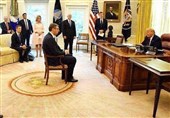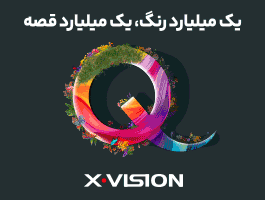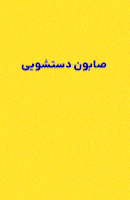جزئیات توافق هستهای ظریف و ۱+۵ توسط وزارت خارجه آمریکا منتشر شد
خبرگزاری تسنیم: وزارت امور خارجه آمریکا درباره توافق سیاسی حاصل شده با ظریف، اطلاعیهای را صادر و جزئیات این تفاهم را بیان کرد. در این جرییات امتیازات داده شده از سوی آقای ظریف شفاف مطرح شده و خبری از لغو یکباره همه تحریمها نیست!!
به گزارش گروه بین الملل خبرگزاری تسنیم، اطلاعیه وزارت خارجه آمریکا درباره تفاهم هستهای حاصل شده با ایران در جریان مذاکرات لوزان شامل موارد زیر است که بر اساس آن ایران برای 15 سال اورانیوم تا 3.67 درصد غنیسازی خواهد کرد. ذخایر اورانیوم ایران به 300 کیلو مواد 3.67 درصد غنیشده تقلیل خواهد یافت و ایران تحت توافق، 6104 سانتریفیوژ خواهد داشت که 5060 عدد آن بهمدت 10 سال غنیسازی خواهند کرد و سانتریفیوژهای آن از نوع آیآر1 خواهند بود.
در ادامه متن کامل اطلاعیه وزارت امور خارجه آمریکا درباره تفاهم هستهای با ایران ارائه میشود.
غنیسازی
ــ تعداد سانتریفیوژهای ایران از 19000 کنونی به 6104 دستگاه میرسد، که در 10 سال آینده تنها 5060 عدد از آنها اورانیوم غنیسازی خواهد کرد. تمامی سانتریفیوژها از نوع IR-1 خواهد بود.
ــ ایران موافقت کرده دستکم بهمدت 15 سال، بالای 3.67درصد غنیسازی نکند.
ــ ایران موافقت کرده است که بهمدت دستکم 15 سال، ذخایر اورانیوم غنیشده خود را از مقدار 10000 کیلوگرم کنونی، به 300 کیلوگرم کاهش دهد.
ــ تمامی سانتریفیوژهای اضافی ایران تحت نظارت آژانس ذخیره شده و تنها برای جایگزینی سانتریفیوژهای فعال مورد استفاده قرار میگیرند.
ــ ایران موافقت کرده است که تا 15 سال هیچ تأسیسات غنیسازی تازهای نسازد.
ــ زمانبندی گریز ایران (زمانی که طول میکشد ایران مواد غنیشده کافی برای یک سلاح داشته باشد) در حال حاضر بین 2 تا 3 ماه ارزیابی میشود. این زمانبندی ذیل این چارچوب، برای دستکم 10 سال، به دستکم یک سال افزایش مییابد.
ــ ایران تأسیسات خود در فردو را تبدیل میکند، بهنحوی که دیگر برای غنیسازی اورانیوم به کار نرود.
ــ ایران موافقت کرده تا بهمدت دستکم 15 سال در تأسیسات فردو غنیسازی اورانیوم انجام ندهد.
ــ ایران موافقت کرده تا تأسیسات فردو را بهنحوی تبدیل کند که تنها برای اهداف صلحآمیز به کار گرفته شود (به مرکز تحقیقات هستهای، فیزیک، فناوری).
ــ ایران موافقت کرده تا دستکم بهمدت 15 سال در فردو تحقیقات و توسعه مرتبط با غنیسازی اورانیوم انجام ندهد.
ــ ایران بهمدت دستکم 15 سال هیچ مواد شکافتپذیری در فردو نخواهد داشت.
ــ تقریباً دوسوم سانتریفیوژها و زیرساختهای فردو حذف خواهد شد. سانتریفیوژهای باقیمانده نیز اورانیوم غنی نخواهد کرد. تمامی سانتریفیوژها و زیرساختهای مربوطه تحت نظارت آژانس بینالمللی انرژی اتمی قرار میگیرد.
ــ ایران برای 10 سال، تنها در تأسیسات نطنز و با تنها 5060 سانتریفیوژ نسل اول (IR-1) اورانیوم غنیسازی میکند.
ــ ایران موافقت کرده تا برای 10 سال، تنها با استفاده از سانتریفیوژهای نسل اول خود (IR-1) در نطنز غنیسازی کرده و تمامی سانتریفیوژهای پیشرفته خود را برمیدارد.
ــ ایران 1000 سانتریفیوژ IR-2M خود را که در حال حاضر در نطنز نصب شده، برداشته و بهمدت 10 سال آنها را در انبار تحت نظارت آژانس بینالمللی انرژی اتمی قرار میدهد.
ــ ایران برای دستکم 10 سال از مدلهای IR-2 ،IR-4 ،IR-5 ،IR-6 یا IR-8 برای تولید اورانیوم غنیشده استفاده نمیکند. ایران بر اساس یک زمانبندی و مؤلفههایی که با 1+5 مورد توافق قرار میگیرد، با سانتریفیوژهای پیشرفته خود، فعالیتهای تحقیقات و توسعه خواهد داشت.
ــ برای 10 سال، غنیسازی و تحقیقات و توسعه غنیسازی محدود خواهد بود، تا از زمان گریز یکساله اطمینان حاصل شود. پس از 10 سال، ایران به طرح غنیسازی و تحقیقات و توسعه غنیسازی که به آژانس بینالمللی انرژی اتمی ارائه شده و مطابق با برنامه اقدام مشترک جامع و ذیل پروتکل الحاقی مقید خواهد بود، که منجر به محدودیتهای مشخص بر ظرفیت غنیسازی میشود.
بازرسی و شفافیت
آژانس بینالمللی به تأسیسات هستهای ایران، از جمله به تأسیسات غنیسازی این کشور در نطنز و تأسیسات غنیسازی پیشین آن در «فردو» دسترسی منظم خواهد داشت و در این راستا از پیشرفتهترین و مدرنترین فناوریهای نظارتی استفاده خواهد کرد.
ــ بازرسها به زنجیره تأمین که پشتیبان برنامه هستهای ایران است، دسترسی خواهند داشت. سازوکارهای بازرسی و شفافیت جدید با نظارت دقیق بر اجزا و مواد هستهای ایران از انحراف این برنامه بهسمت برنامهای مخفیانه جلوگیری خواهد کرد. بازرسها به زنجیره تأمین که پشتیبان برنامه هستهای ایران است، دسترسی خواهند داشت. سازوکارهای بازرسی و شفافیت جدید با نظارت دقیق بر اجزا و مواد هستهای ایران از انحراف این برنامه بهسمت برنامهای مخفیانه جلوگیری خواهد کرد.
ــ بازرسها به معادن اورانیوم دسترسی خواهند داشت و در کارخانههای اورانیوم که ایران بهمدت 25 سال اقدام به تولید کیک زرد کرده پایش مستمر انجام خواهند داد.
ــ بازرسها از روتورهای سانتریفیوژ ایران نظارت مستمر به عمل خواهند آورد و تأسیسات تولید و ذخیره اورانیوم ایران را برای 20 سال در معرض نظارت قرار خواهند داد. پایگاه ساخت سانتریفیوژ ایران متوقف شده و تحت نظارت مستمر قرار خواهد گرفت.
ــ تمامی سانتریفیوژها و زیرساختهای برداشته شده از فردو و نطنز تحت نظارت مستمر آژانس بینالمللی انرژی اتمی قرار خواهند گرفت.
ــ یک کانال تدارکاتی انحصاری بهمنظور نظارت و تأیید تک تک موارد مربوط به تأمین، فروش و انتقال مواد و فناوریهای هستهای و مواد دارای استفادههای دوگانه به ایران ایجاد خواهد شد.
ــ ایران با اجرای پروتکل الحاقی آژانس بینالمللی انرژی اتمی موافقت کرده که به آژانس امکان اطلاعات و دسترسی بیشتر به برنامه هستهای ایران، هم در تأسیسات اعلام شده و هم در تأسیسات اعلامنشده فراهم میآورد.
ــ ایران ملزم خواهد بود به آژانس دسترسیهای لازم برای تحقیق درباره تأسیسات مشکوک این کشور یا تحقیق درباره ادعاهای وجود تأسیسات غنیسازی پنهان، تأسیسات تبدیل (اورانیوم)، تأسیسات تولید سانتریفیوژ یا تأسیسات تولید کیک زرد در هر نقطه از آن کشور فراهم کند.
ــ ایران موافقت کرده کد اصلاحی 3.1 را که مستلزم اطلاعرسانی زودهنگام درباره ساخت تأسیسات جدید است، اجرا کند.
ــ ایران اقدام به اجرای مجموعهای مورد توافق از اقدامات برای پرداختن به نگرانیهای آژانس بینالملل انرژی اتمی درباره جنبههای نظامی احتمالی برنامه هستهای خود خواهد کرد.
رآکتورها و بازفرآوری
ــ ایران موافقت کرده رآکتور تحقیقاتی آب سنگین در اراک را بر اساس طراحی مورد توافق با 1+5، بازطراحی و بازسازی کند، بهنحوی که دیگر پلوتونیوم سطح تسلیحاتی تولید نکرده و تحقیقات و تولید رادیو ایزوتوپ را امکانپذیر کند.
ــ هسته اصلی رآکتور که میتوانست مقادیر قابل توجه پلوتونیوم سطح تسلیحاتی تولید کند، نابود شده یا از کشور خارج میشود.
ــ ایران در طول عمر رآکتور، تمام سوخت مصرفشده رآکتور را به خارج از کشور منتقل میکند.
ــ ایران بهصورت نامحدود، متعهد شده است که بازفرآوری یا تحقیق و توسعه بازفرآوری بر سوخت هستهای مصرفشده، انجام ندهد.
ــ ایران بهمدت 15 سال، فراتر از نیازهای رآکتور اصلاحشده اراک، آب سنگین انباشت نکرده و تمامی آب سنگین باقیمانده را در بازارهای بینالمللی به فروش میرساند.
ــ ایران بهمدت 15 سال، هیچ رآکتور آب سنگین دیگری نمیسازد.
تحریمها
ــ ایران در صورتی که بهصورتی قابل راستیآزمایی به تعهدات خود پایبند باشد، تخفیف تحریمی دریافت خواهد کرد.
ــ آمریکا و اتحادیه اروپا زمانی که آژانس تأیید کند ایران تمام گامهای کلیدی مرتبط با هستهای را برداشته، تحریمهای مرتبط با هستهای را تعلیق خواهند کرد. در هر زمان که ایران به تعهدات خود عمل نکند، این تحریمها فوراً به جای خود بازمیگردند.
ــ معماری تحریمهای مرتبط با هستهای ایالات متحده در بخش اعظم دوره توافق حفظ شده و امکان بازگشت فوری آنها درصورت بروز مورد جدی عدمکارایی را فراهم میکند.
ــ تمامی قطعنامههای پیشین شورای امنیت سازمان ملل مرتبط با مسئله هستهای ایران همزمان با تکمیل اقدامات مرتبط با هستهای که نگرانیهای کلیدی (غنیسازی، فردو، اراک، ابعاد احتمالی نظامی و شفافیت) را پاسخ دهد، برداشته میشود.
ــ با این حال، مجوزهای اصلی در قطعنامه شورای امنیت سازمان ملل (آنهایی که مربوط به انتقال فعالیتها و فناوریهای حساس است)، با یک قطعنامه جدید شورای امنیت سازمان ملل که برنامه اقدام مشترک جامع را تأیید میکند، بار دیگر برقرار میشوند. این (قطعنامه) همچنین کانال اکتساب فوقالذکر را ایجاد میکند، که یک تمهید شفافسازی کلیدی به شمار میآید. در این قطعنامه، محدودیتهای مهم بر تسلیحات متعارف و موشکهای بالستیک و همچنین مجوزهایی که اجازه بازرسی محمولهها و بلوکه داراییها را میدهد، وجود خواهد داشت.
ــ یک روند حل مناقشه تعریف میشود که تمامی طرفهای برنامه اقدام مشترک جامع را قادر میسازد، برای حل اختلاف نظرها در مورد اجرای برنامه اقدام مشترک جامع تلاش کنند.
ــ در صورتی که یک مسئله عدمکارایی قابل توجه را نتوان از طریق آن روند حل کرد، آنوقت تمامی تحریمهای پیشین سازمان ملل میتوانند بار دیگر اعمال شوند.
ــ ذیل توافق، تحریمهای ایالات متحده مرتبط با مسئله تروریسم، نقض حقوق بشر و موشکهای بالستیک پابرجا خواهند بود.
زمانبندی
ــ بهمدت 10 سال، ایران ظرفیت غنیسازی و تحقیق و توسعه خود را محدود میکند، که این امر زمان گریز دستکم یکساله را تضمین میکند. فراتر از آن، ایران به طرحهای غنیسازی بلندمدت و تحقیق و توسعه غنیسازی که با 1+5 به اشتراک گذاشته شده، مقید خواهد بود.
ــ بهمدت 15 سال، ایران عناصر اضافی برنامه خود را محدود خواهد کرد، بهعنوان نمونه، ایران تأسیسات غنیسازی جدید یا رآکتورهای آب سنگین نساخته و ذخایر اورانیوم غنیشده خود را محدود کرده و فرآیندهای پیشرفته شفافیت را میپذیرد.
ــ تمهیدات مهم بازرسی و شفافسازی پس از 15 سال نیز ادامه خواهد داشت. پایبندی ایران به پروتکل الحاقی آژانس بینالمللی انرژی انمی، از جمله دسترسی قابل توجه و تعهدات شفافسازی، دائمی خواهد بود. بازرسیهای قدرتمند زنجیره تأمین اورانیوم ایران برای دستکم 25 سال، ادامه خواهد داشت.
ــ حتی پس از دوره سختترین محدودیتهای برنامه هستهای ایران، ایران همچنان عضوی از پیمان منع گسترش هستهای است، که ایران را از توسعه و دستیابی به تسلیحات هستهای منع کرده و اعمال پادمانهای آژانس بینالمللی انرژی اتمی بر این برنامه را ضروری میکند.
متن انگلیسی توافق بهشرح زیر است:
Parameters for a Joint Comprehensive Plan of Action regarding the Islamic Republic of Iran's Nuclear Program
Below are the key parameters of a Joint Comprehensive Plan of Action (JCPOA) regarding the Islamic Republic of Iran's nuclear program that were decided in Lausanne, Switzerland. These elements form the foundation upon which the final text of the JCPOA will be written between now and June 30, and reflect the significant progress that has been made in discussions between the P5+1, the European Union, and Iran. Important implementation details are still subject to negotiation, and nothing is agreed until everything is agreed. We will work to conclude the JCPOA based on these parameters over the coming months.
Enrichment
• Iran has agreed to reduce by approximately two-thirds its installed centrifuges. Iran will go from having about 19,000 installed today to 6,104 installed under the deal, with only 5,060 of these enriching uranium for 10 years. All 6,104 centrifuges will be IR-1s, Iran's first-generation centrifuge.
• Iran has agreed to not enrich uranium over 3.67 percent for at least 15 years.
• Iran has agreed to reduce its current stockpile of about 10,000 kg of low-enriched uranium (LEU) to 300 kg of 3.67 percent LEU for 15 years.
• All excess centrifuges and enrichment infrastructure will be placed in IAEA monitored storage and will be used only as replacements for operating centrifuges and equipment.
• Iran has agreed to not build any new facilities for the purpose of enriching uranium for 15 years.
• Iran's breakout timeline -- the time that it would take for Iran to acquire enough fissile material for one weapon -- is currently assessed to be 2 to 3 months. That timeline will be extended to at least one year, for a duration of at least ten years, under this framework.
Iran will convert its facility at Fordow so that it is no longer used to enrich uranium
• Iran has agreed to not enrich uranium at its Fordow facility for at least 15 years.
• Iran has agreed to convert its Fordow facility so that it is used for peaceful purposes only -- into a nuclear, physics, technology, research center.
• Iran has agreed to not conduct research and development associated with uranium enrichment at Fordow for 15 years.
• Iran will not have any fissile material at Fordow for 15 years.
• Almost two-thirds of Fordow's centrifuges and infrastructure will be removed. The remaining centrifuges will not enrich uranium. All centrifuges and related infrastructure will be placed under IAEA monitoring.
Iran will only enrich uranium at the Natanz facility, with only 5,060 IR-1 first-generation centrifuges for ten years.
• Iran has agreed to only enrich uranium using its first generation (IR-1 models) centrifuges at Natanz for ten years, removing its more advanced centrifuges.
• Iran will remove the 1,000 IR-2M centrifuges currently installed at Natanz and place them in IAEA monitored storage for ten years.
• Iran will not use its IR-2, IR-4, IR-5, IR-6, or IR-8 models to produce enriched uranium for at least ten years. Iran will engage in limited research and development with its advanced centrifuges, according to a schedule and parameters which have been agreed to by the P5+1.
• For ten years, enrichment and enrichment research and development will be limited to ensure a breakout timeline of at least 1 year. Beyond 10 years, Iran will abide by its enrichment and enrichment R&D plan submitted to the IAEA, and pursuant to the JCPOA, under the Additional Protocol resulting in certain limitations on enrichment capacity.
Inspections and Transparency
• The IAEA will have regular access to all of Iran's nuclear facilities, including to Iran's enrichment facility at Natanz and its former enrichment facility at Fordow, and including the use of the most up-to-date, modern monitoring technologies.
• Inspectors will have access to the supply chain that supports Iran's nuclear program. The new transparency and inspections mechanisms will closely monitor materials and/or components to prevent diversion to a secret program.
• Inspectors will have access to uranium mines and continuous surveillance at uranium mills, where Iran produces yellowcake, for 25 years.
• Inspectors will have continuous surveillance of Iran's centrifuge rotors and bellows production and storage facilities for 20 years. Iran's centrifuge manufacturing base will be frozen and under continuous surveillance.
• All centrifuges and enrichment infrastructure removed from Fordow and Natanz will be placed under continuous monitoring by the IAEA.
• A dedicated procurement channel for Iran's nuclear program will be established to monitor and approve, on a case by case basis, the supply, sale, or transfer to Iran of certain nuclear-related and dual use materials and technology -- an additional transparency measure.
• Iran has agreed to implement the Additional Protocol of the IAEA, providing the IAEA much greater access and information regarding Iran's nuclear program, including both declared and undeclared facilities.
• Iran will be required to grant access to the IAEA to investigate suspicious sites or allegations of a covert enrichment facility, conversion facility, centrifuge production facility, or yellowcake production facility anywhere in the country.
• Iran has agreed to implement Modified Code 3.1 requiring early notification of construction of new facilities.
• Iran will implement an agreed set of measures to address the IAEA's concerns regarding the Possible Military Dimensions (PMD) of its program.
Reactors and Reprocessing
• Iran has agreed to redesign and rebuild a heavy water research reactor in Arak, based on a design that is agreed to by the P5+1, which will not produce weapons grade plutonium, and which will support peaceful nuclear research and radioisotope production.
• The original core of the reactor, which would have enabled the production of significant quantities of weapons-grade plutonium, will be destroyed or removed from the country.
• Iran will ship all of its spent fuel from the reactor out of the country for the reactor's lifetime.
• Iran has committed indefinitely to not conduct reprocessing or reprocessing research and development on spent nuclear fuel.
• Iran will not accumulate heavy water in excess of the needs of the modified Arak reactor, and will sell any remaining heavy water on the international market for 15 years.
• Iran will not build any additional heavy water reactors for 15 years.
Sanctions
• Iran will receive sanctions relief, if it verifiably abides by its commitments.
• U.S. and E.U. nuclear-related sanctions will be suspended after the IAEA has verified that Iran has taken all of its key nuclear-related steps. If at any time Iran fails to fulfill its commitments, these sanctions will snap back into place.
• The architecture of U.S. nuclear-related sanctions on Iran will be retained for much of the duration of the deal and allow for snap-back of sanctions in the event of significant non-performance.
• All past UN Security Council resolutions on the Iran nuclear issue will be lifted simultaneous with the completion, by Iran, of nuclear-related actions addressing all key concerns (enrichment, Fordow, Arak, PMD, and transparency).
• However, core provisions in the UN Security Council resolutions -- those that deal with transfers of sensitive technologies and activities -- will be re-established by a new UN Security Council resolution that will endorse the JCPOA and urge its full implementation. It will also create the procurement channel mentioned above, which will serve as a key transparency measure. Important restrictions on conventional arms and ballistic missiles, as well as provisions that allow for related cargo inspections and asset freezes, will also be incorporated by this new resolution.
• A dispute resolution process will be specified, which enables any JCPOA participant, to seek to resolve disagreements about the performance of JCPOA commitments.
• If an issue of significant non-performance cannot be resolved through that process, then all previous UN sanctions could be re-imposed.
• U.S. sanctions on Iran for terrorism, human rights abuses, and ballistic missiles will remain in place under the deal.
Phasing
• For ten years, Iran will limit domestic enrichment capacity and research and development -- ensuring a breakout timeline of at least one year. Beyond that, Iran will be bound by its longer-term enrichment and enrichment research and development plan it shared with the P5+1.
• For fifteen years, Iran will limit additional elements of its program. For instance, Iran will not build new enrichment facilities or heavy water reactors and will limit its stockpile of enriched uranium and accept enhanced transparency procedures.
• Important inspections and transparency measures will continue well beyond 15 years. Iran's adherence to the Additional Protocol of the IAEA is permanent, including its significant access and transparency obligations. The robust inspections of Iran's uranium supply chain will last for 25 years.
• Even after the period of the most stringent limitations on Iran's nuclear program, Iran will remain a party to the Nuclear Non-Proliferation Treaty (NPT), which prohibits Iran's development or acquisition of nuclear weapons and requires IAEA safeguards on its nuclear program.
انتهای پیام/.*

